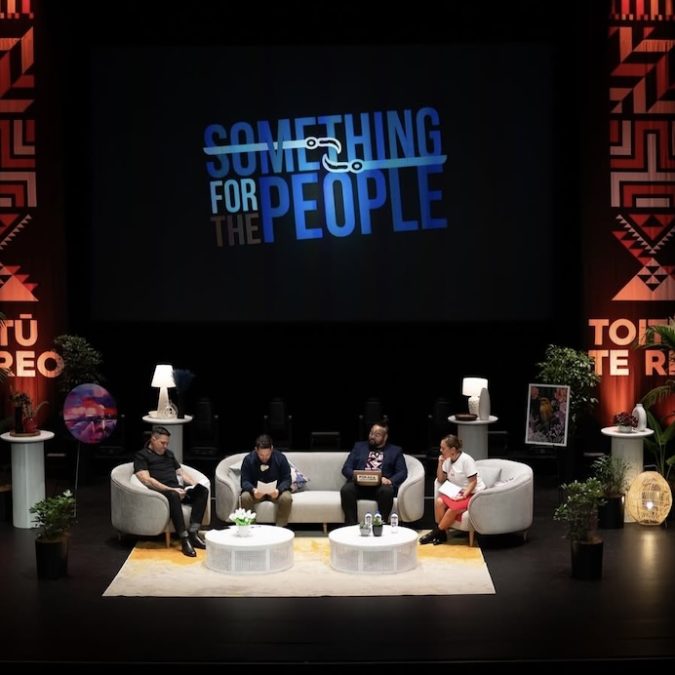Te paparahi, Toi M?ori: The wonderful guide to M?ori public art in Auckland City

The booklet is small, but it’s filled with M?ori history. Some of the artworks presented are familiar to many: the hotly debated piece, The Lighthouse by Michael Parek?whai, or the prominent Tauranga Waka Carvings by Chris Bailey, while others are more hidden, like the symbolic Ng?ti Paoa Seating at Vic Park by Puhi Thomson. Whether acclaimed, or not, the booklet gives attention to over 60 pieces of M?ori public art that decorate our cityscape.
Haddon says the decision to create the book tied into the Auckland Plan, which highlighted key issues important to Aucklanders. One being, our unique M?ori identity as a point of difference in the world.
Haddon says, “We did an audit of the city centre on what is contributing to M?ori identity with a focus on the built environment. So, what we found was a lot of M?ori material culture and expression hasn’t been highlighted or made visible for the people to enjoy. One of the biggest contributors to M?ori identity is not the buildings themselves but public art – or stand alone art pieces – that are in the public realm.
“We thought there was a significant number of these items that we wanted to create an experience for Aucklanders, and visitors, which they can tap into.”
The book also features eight different destinations across the city centre, each purposefully categorised into traditional M?ori place names, which aim to give the public a deeper understanding of the indigeneity of Auckland. One example, is Pukekawa – or alternatively, the Auckland Domain – which informs readers on how the name was formed; a memorial to the bitter memories of those who lost their lives in the brutal land wars in the 1870s.
{% gallery ‘walks-city’ %}
Haddon speaks of the process: “Every item that contributed to M?ori identity was plotted in a GPS map – this was just part of what we found in the city. So, we categorised after a lot of research, and also looked at council databases which have publicly owned artworks listed on a databases, plus other items that weren’t listed in the public realm, which were either owned by corporates or privately owned pieces.”
Haddon adds that most of the works have M?ori significance with input by Iwi, or are made by M?ori artists, and some are made by mana whenua artists. It also features a significant selection of masters in M?ori art, such as Selwyn Selwyn Muru, Ralph Hotere, and Lisa Reihana, alongside traditional carvers, among others.
The guide also comes in digital app form, named AKL City Tours listed as Te Paparahi, Toi, which can be simply downloaded on Apple or Android and enables users to plot their own walks. Both the app and the book have been very popular according to Haddon who exclaims, “copies have been flying out the door”. And subsequently, Auckland Council has called for a reprint.
“People from all walks of life are loving it. It shows that there is a real hunger and interest in M?ori expression of identity. And what it also highlights is how diverse that expression is, how contemporary yet traditional it is.
“In our reprint we are including two more works, which we didn’t pick up on originally, but on reflection realise they are really important down in the Wynyard Quarter. We have also had students approach us recently, and they wish to translate the stories into different languages to engage international visitors.”
Haddon shares how she would love to extend the narrative into the regions, where there is a lot of wonderful artworks and carvings to explore, but is currently constrained to Auckland city.
Further asked how we can best quench the thirst for more information about M?ori expression and stories of heritage in our city spaces, Haddon says, “there is wonderful work going on with the infrastructure development in downtown Auckland, the revisioning of the waterfront, and that starts with an engagement in relationship with the people in the place: the tangata whenua alongside the mana whenua.
“There is always cultural layers of habitation, values, and stories associated to place. I always find that art and artists are able to express that beautifully across many medians.”
Haddon says the opportunities in new avenues of story telling, such as augmented reality and virtual reality, where people can interact with narratives about a place.
A recent example of this saw video production agency Wrestler transform Wellington into an interactive virtual reality experience, which aimed to immerse people in the city’s atmosphere.




